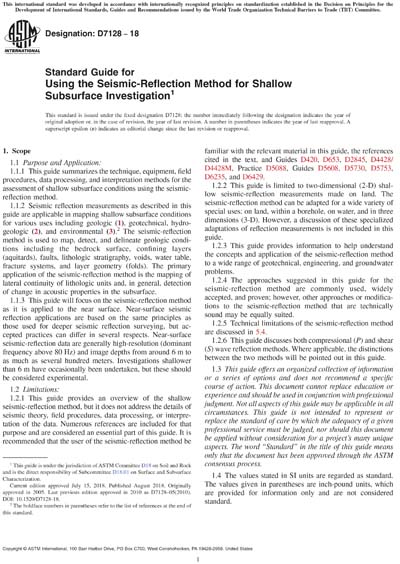Most recent
ASTM D7128-18
Standard Guide for Using the Seismic-Reflection Method for Shallow Subsurface Investigation
1.1 Purpose and Application:
1.1.1 This guide summarizes the technique, equipment, field procedures, data processing, and interpretation methods for the assessment of shallow subsurface conditions using the seismic-reflection method.
1.1.2 Seismic reflection measurements as described in this guide are applicable in mapping shallow subsurface conditions for various uses including geologic (1), geotechnical, hydrogeologic (2), and environmental (3).2 The seismic-reflection method is used to map, detect, and delineate geologic conditions including the bedrock surface, confining layers (aquitards), faults, lithologic stratigraphy, voids, water table, fracture systems, and layer geometry (folds). The primary application of the seismic-reflection method is the mapping of lateral continuity of lithologic units and, in general, detection of change in acoustic properties in the subsurface.
1.1.3 This guide will focus on the seismic-reflection method as it is applied to the near surface. Near-surface seismic reflection applications are based on the same principles as those used for deeper seismic reflection surveying, but accepted practices can differ in several respects. Near-surface seismic-reflection data are generally high-resolution (dominant frequency above 80 Hz) and image depths from around 6 m to as much as several hundred meters. Investigations shallower than 6 m have occasionally been undertaken, but these should be considered experimental.
1.2 Limitations:
1.2.1 This guide provides an overview of the shallow seismic-reflection method, but it does not address the details of seismic theory, field procedures, data processing, or interpretation of the data. Numerous references are included for that purpose and are considered an essential part of this guide. It is recommended that the user of the seismic-reflection method be familiar with the relevant material in this guide, the references cited in the text, and Guides D420, D653, D2845, D4428/D4428M, Practice D5088, Guides D5608, D5730, D5753, D6235, and D6429.
1.2.2 This guide is limited to two-dimensional (2-D) shallow seismic-reflection measurements made on land. The seismic-reflection method can be adapted for a wide variety of special uses: on land, within a borehole, on water, and in three dimensions (3-D). However, a discussion of these specialized adaptations of reflection measurements is not included in this guide.
1.2.3 This guide provides information to help understand the concepts and application of the seismic-reflection method to a wide range of geotechnical, engineering, and groundwater problems.
1.2.4 The approaches suggested in this guide for the seismic-reflection method are commonly used, widely accepted, and proven; however, other approaches or modifications to the seismic-reflection method that are technically sound may be equally suited.
1.2.5 Technical limitations of the seismic-reflection method are discussed in 5.4.
1.2.6 This guide discusses both compressional (P) and shear (S) wave reflection methods. Where applicable, the distinctions between the two methods will be pointed out in this guide.
1.3 This guide offers an organized collection of information or a series of options and does not recommend a specific course of action. This document cannot replace education or experience and should be used in conjunction with professional judgment. Not all aspects of this guide may be applicable in all circumstances. This guide is not intended to represent or replace the standard of care by which the adequacy of a given professional service must be judged, nor should this document be applied without consideration for a project’s many unique aspects. The word “Standard” in the title of this guide means only that the document has been approved through the ASTM consensus process.
1.4 The values stated in SI units are regarded as standard. The values given in parentheses are inch-pound units, which are provided for information only and are not considered standard.
1.5 Precautions:
1.5.1 It is the responsibility of the user of this guide to follow any precautions within the equipment manufacturer’s recommendations, establish appropriate health and safety practices, and consider the safety and regulatory implications when explosives or any high-energy (mechanical or chemical) sources are used.
1.5.2 If the method is applied at sites with hazardous materials, operations, or equipment, it is the responsibility of the user of this guide to establish appropriate safety and health practices and determine the applicability of any regulations prior to use.
1.5.3 This standard does not purport to address all of the safety concerns, if any, associated with its use. It is the responsibility of the user of this standard to establish appropriate safety, health, and environmental practices and determine the applicability of regulatory limitations prior to use.
1.6 This international standard was developed in accordance with internationally recognized principles on standardization established in the Decision on Principles for the Development of International Standards, Guides and Recommendations issued by the World Trade Organization Technical Barriers to Trade (TBT) Committee.
Content Provider
ASTM International [astm]






